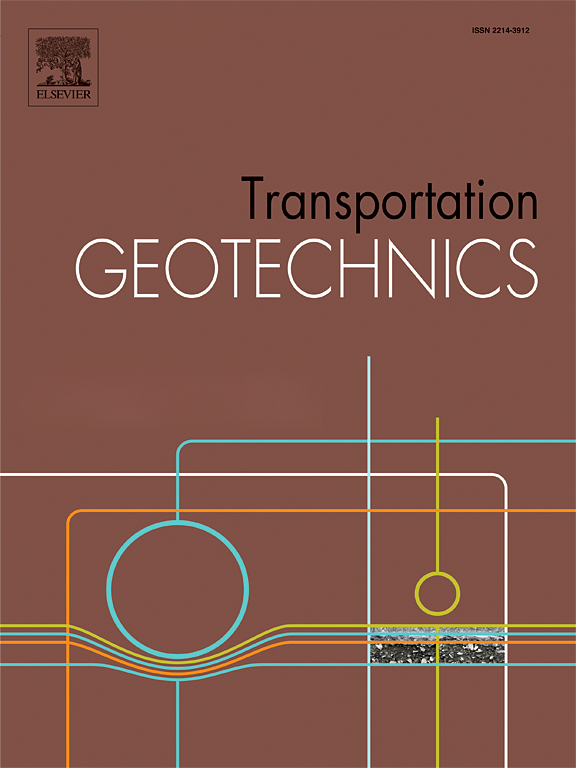在恶劣环境下,安装损伤对聚丙烯土工格栅性能的影响
IF 4.9
2区 工程技术
Q1 ENGINEERING, CIVIL
引用次数: 0
摘要
这项研究探讨了安装损坏对聚丙烯土工格栅在侵蚀性环境中的行为的影响,从而对产品在恶劣条件下的长期行为进行了更真实的评估。这项研究的创新之处在于从微观和宏观尺度评估了安装损坏和化学降解对土工合成材料的综合影响。为此,实验测试分两个阶段进行。在第一阶段,对原生土工格栅分别进行了全面的现场安装试验和加速老化试验,特别是在 80 °C 下浸泡在浓度为 3.1 mol/L 的硫酸(H2SO4)中。在第二阶段,先前在安装试验中受损的土工格栅将接受加速老化试验(综合降解)。通过拉伸试验监测土工格栅机械性能的变化,评估土工格栅在降解试验后受到的损坏。此外,还进行了差示扫描量热分析,以评估聚丙烯的热特性和形态特性的变化,并通过扫描电子显微镜检查了土工格栅的表面形态。研究结果表明,与未受损的土工格栅相比,化学侵蚀对安装过程中受损的土工格栅的热性能和机械性能的影响较小。具体来说,在整个老化过程中,综合降解后的拉伸强度降低了 17.59% - 26.38%,而老化试验(单一降解)后的拉伸强度降低了 27.19% - 39.75%。这项调查强调了考虑降解剂综合效应的重要性,以提高土工合成材料在实际条件下性能的可预测性,从而确保优化基础设施的使用寿命。本文章由计算机程序翻译,如有差异,请以英文原文为准。
Effect of installation damage on the behavior of a polypropylene geogrid in an aggressive environment
This study explores the effect of installation damage on the behavior of a polypropylene geogrid in an aggressive environment, providing a more realistic assessment of the long-term product behavior under severe conditions. The study’s novelty resides in evaluating the combined effect of installation damage and chemical degradation on the geosynthetic at microscopic and macroscopic scales. To this end, experimental tests were conducted in two phases. In the first phase, a full-scale field installation test and an accelerated aging test— specifically, immersion in sulfuric acid (H2SO4) at a concentration of 3.1 mol/L at 80 °C—were performed separately on a virgin geogrid. In the second phase, the geogrid previously damaged under the installation test was exposed to the accelerated aging test (combined degradation). The damage sustained by the geogrid after the degradation tests was evaluated by monitoring changes in its mechanical behavior using the tensile test. In addition, differential scanning calorimetry analysis was performed to assess the evolution of the thermal and morphological properties of the polypropylene, while the surface morphology of the geogrid was examined through scanning electron microscopy. The findings demonstrated that chemical attack has a less pronounced effect on the thermal and mechanical behavior of the geogrid previously damaged during the installation process compared to the undamaged geogrid. Specifically, throughout the aging time, the reductions in tensile strength ranged from 17.59 − 26.38 % following combined degradation, compared to 27.19 − 39.75 % after the aging test (single degradation). This investigation underscores the significance of considering the combined effects of degradation agents to enhance the predictability of geosynthetics’ performance in real conditions, thereby ensuring the optimization of infrastructure longevity.
求助全文
通过发布文献求助,成功后即可免费获取论文全文。
去求助
来源期刊

Transportation Geotechnics
Social Sciences-Transportation
CiteScore
8.10
自引率
11.30%
发文量
194
审稿时长
51 days
期刊介绍:
Transportation Geotechnics is a journal dedicated to publishing high-quality, theoretical, and applied papers that cover all facets of geotechnics for transportation infrastructure such as roads, highways, railways, underground railways, airfields, and waterways. The journal places a special emphasis on case studies that present original work relevant to the sustainable construction of transportation infrastructure. The scope of topics it addresses includes the geotechnical properties of geomaterials for sustainable and rational design and construction, the behavior of compacted and stabilized geomaterials, the use of geosynthetics and reinforcement in constructed layers and interlayers, ground improvement and slope stability for transportation infrastructures, compaction technology and management, maintenance technology, the impact of climate, embankments for highways and high-speed trains, transition zones, dredging, underwater geotechnics for infrastructure purposes, and the modeling of multi-layered structures and supporting ground under dynamic and repeated loads.
 求助内容:
求助内容: 应助结果提醒方式:
应助结果提醒方式:


